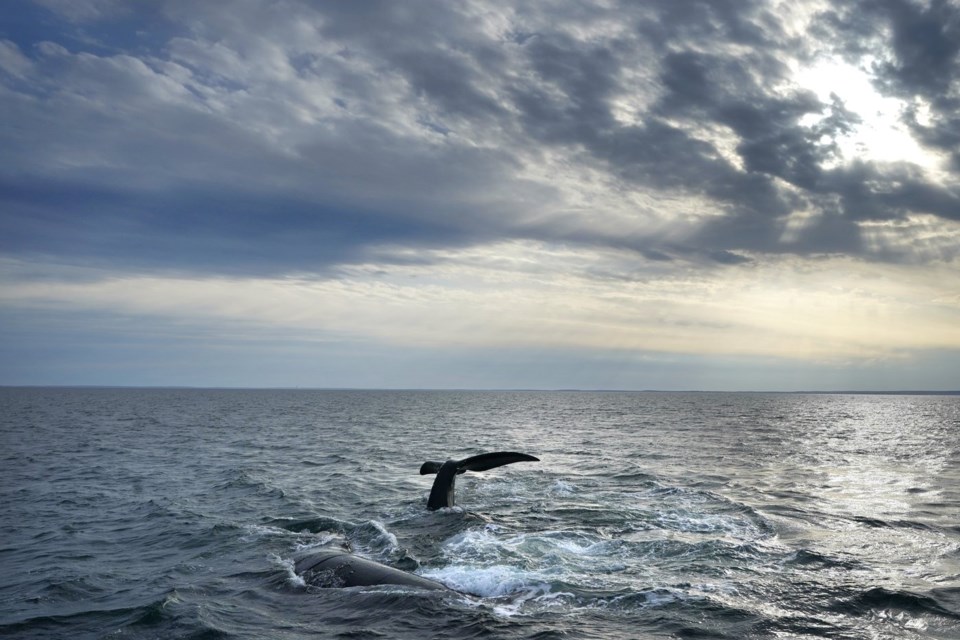HALIFAX — The estimated population of North Atlantic right whales increased in 2023, but marine scientists say human behaviour still poses a significant threat to the critically endangered species.
The new data released Tuesday by the North Atlantic Right Whale Consortium estimates the population of right whales in 2023 was 372, up from the prior year's estimate of 356. This year’s figures includes 12 calves born in 2023.
But the new data should not be taken as a turning point for the endangered species, Philip Hamilton, a senior scientist at the New England Aquarium in Boston, said in a recent interview. Although the rise in whale numbers is good news, there’s been a “sobering” increase in deaths and injuries caused by marine vessels and equipment in 2024.
“Both the whales and humans are using the ocean, and so there will be a conflict,” Hamilton said.
So far this year, scientists have detected five deaths of right whales, one of whom was killed after being entangled in rope for more than one year. Three other whales died after they were struck by vessels. The body of the fifth whale could not be retrieved, leaving scientists without information on how it died.
Hamilton said entanglement with fishing gear is a leading cause of death for right whales, adding that 85 per cent of the population will become entangled at some point in their lives. Entanglements are not always lethal, and whales can usually break free from ropes or drag them while they swim, he said.
Nonetheless, he said, rope entanglements for right whales lead to “gruesome and very painful” deaths.
“In some cases it’s actually a sort of blood poisoning or septicemia that kills them. Either that or they get thinner and thinner because they’re not able to feed, maybe not at all or not as efficiently,” Hamilton said.
“If you saw a dog that was bound up and the collar was cutting into their body for a year, it would be horrifying. It’s a real challenge that right whales are kind of out of sight.”
Vessel strikes, meanwhile, are less common but are almost always lethal. A release from environment advocacy group Oceana said North Atlantic right whales — who are already difficult to spot because they’re dark in colour — usually swim at a speed of approximately 9.5 kilometres per hour near the water’s surface, too slowly to get out of the way of vessels travelling at faster speeds.
The report also reports four calves that are presumed to have died this year.
Heather Pettis, a research scientist at the New England Aquarium, said calves are presumed to have died when a mother whale who has been previously spotted with a calf is sighted again without her calf, or when a mother is killed.
“The calves really are dependent on their mothers for the first year of life,” Pettis said.
Hamilton and Pettis said it’s not clear what to expect for 2024’s population estimate. Pettis said the number of deaths could always be higher than what's recorded.
To get population levels back up, Pettis and Hamilton stressed the need for better species management. That involves the Canadian and American governments working together to develop policy and regulation protecting the species and halting use of dangerous equipment in areas where right whales are known to be.
“They need protection throughout their range,” Pettis said, stressing that whales need to be able to move in the ocean without running into boats or ropes.
Kim Elmslie, campaign director at Oceana Canada, called for the National Oceanic and Atmospheric Administration, federal Fisheries Department and Transport Canada to increase protections for the species.
“To ensure whales and fisheries can coexist in Canada, the government must implement ropeless fishing gear in high-risk areas," Elmslie said in a news release. "Additionally, all vessel slowdowns must be mandatory and be applied throughout the range where right whales are found to reduce ship strikes."
North Atlantic right whales travel to Atlantic Canadian waters largely to feed. They used to migrate more to the Bay of Fundy to feed on plankton but have gradually migrated to feeding grounds in the Gulf of St. Lawrence as ocean temperatures change.
The species migrates between the coast of Florida to the Gulf of St. Lawrence.
This report by The Canadian Press was first published Oct. 22, 2024.
Cassidy McMackon, The Canadian Press

